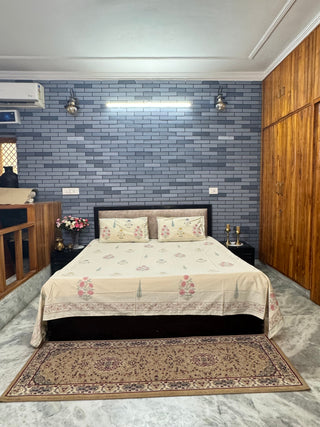Ajrakh print, with its distinctive geometric patterns and vibrant colours, holds a special place in the world of traditional textile arts in India. Originating from the ancient Indus Valley Civilization, this craft has transcended centuries and borders, leaving an indelible mark on the cultural fabric of the Indian subcontinent. In this article, we will explore the history, intricate process, and cultural significance of Ajrak print.
History and Origins:
Ajrak print finds its roots in the fertile plains of the Indus Valley, where evidence of its existence dates back to the time of the ancient civilization that thrived along the banks of the river Indus. The term "Ajrakh" is believed to have been derived from the word "Azrak," meaning blue, which is a predominant colour in many Ajrakh designs. Over the centuries, this traditional art form has been passed down through generations, with each artisan adding their unique touch to the craft.
The Ajrak Print Process:
- Preparation of Fabric:
- Ajrak printing typically involves the use of natural fibres such as cotton or silk. The fabric is first washed, treated with a mixture of camel dung and castor oil, and then sun-dried to prepare it for the printing process.
- Block Carving:
- The heart of Ajrakh printing lies in the intricately carved wooden blocks. Skilled artisans carve these blocks by hand, creating elaborate geometric patterns that form the basis of Ajrakh designs. The patterns often include stars, flowers, and other geometric motifs.
- Mordant Application:
- The fabric is soaked in a mixture of myrobalan (a natural mordant) and water, which helps in fixing the colours to the fabric. This step is crucial for achieving the vibrant and long-lasting colour that Ajrakh is known for.
- Block Printing:
- Artisans use the hand-carved wooden blocks to print the intricate patterns onto the fabric. The process requires precision and skill to ensure that the design is evenly transferred. Multiple blocks are used to create layered and complex designs.
- Natural Dyeing:
- Ajrakh prints are characterised by their rich and earthy colours, often obtained from natural sources such as indigo, madder root, and pomegranate peel. Each colour is applied separately, with the fabric being dried in the sun between each dyeing stage.
- Resist Printing:
- To create the characteristic white patterns on the fabric, a resist paste made from clay and gum is applied using wooden blocks. This resist paste protects certain areas of the fabric from absorbing the dye during subsequent rounds of colour application.
- Finishing Touches:
- Once the entire printing and dyeing process is complete, the fabric undergoes a final wash to remove any excess dye or resist paste. The result is a stunning piece of textile art with intricate patterns and a unique blend of colours.
Cultural Significance:
Ajrakh print is not merely a form of textile art; it is a cultural symbol deeply rooted in the traditions of the Sindhi people. The designs often carry symbolic meanings, reflecting the natural elements, spirituality, and the cultural heritage of the region. Ajrakh-printed textiles are worn with pride, especially during special occasions and ceremonies, making them an integral part of the social and cultural identity of the community.
Revival and Contemporary Expression:
In recent years, there has been a renewed interest in traditional crafts of India, and Ajrakh print has found its way into the global fashion and design scene. Contemporary designers and artisans are experimenting with innovative ways to incorporate Ajrakh prints into clothing, accessories, and home decor, bridging the gap between tradition and modernity.
Ajrakh print, with its roots deeply embedded in the history and culture of the Indian subcontinent, continues to weave a timeless narrative through its intricate patterns and vibrant hues. As we celebrate the revival of traditional crafts, Ajrak print stands as a testament to the enduring legacy of artistic expression, connecting the past with the present in a tapestry of colour and tradition.


